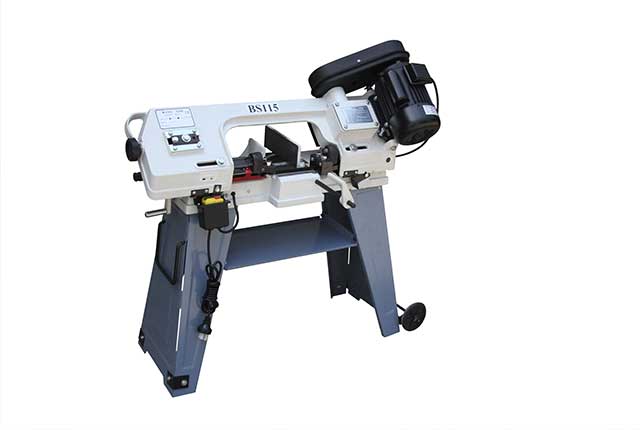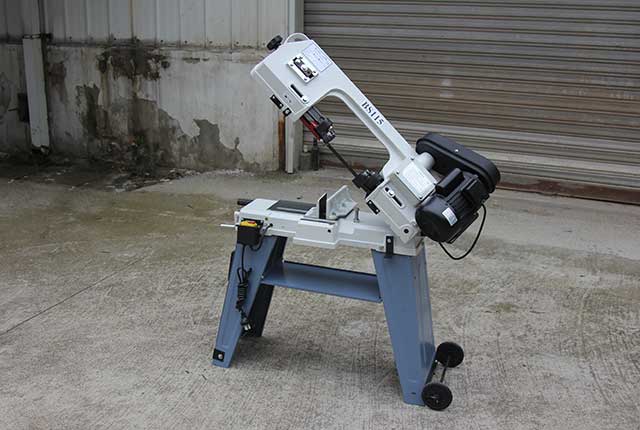WMT CNC Industrial Co., Ltd | All Rights Reserved.Design & Developed by VW Themes

A bandsaw (also written band saw) is a power saw with a long, sharp blade consisting of a continuous band of toothed metal stretched between two or more wheels to cut material. They are used principally in woodworking, metalworking, and lumbering, but may cut a variety of materials.
1. Special designed horizontal and vertical band saw.
2. Offers three speeds for cutting metal plastic or wood.
3. Shuts off automatically when material is cut.
4. With scale for the mitering vise.
5. No noise while operating.
6. Casters (optional) quick and easy moving.
1. Capacity: 41/2’’ (115mm) round
4’’x6’’ (100mmx150mm) rectangular
2. Speeds: 80-120-200 FPM 60HZ (65-95-165 FPM 50HZ)
3. Motor: 1/3HP or 1/2HP 1700 RPM 60HZ (1400RPM 50 HZ)
4. Blades: 1/2’’x1/40’’x641/2’’ (12.5mmx0.64mmx1638mm)
5. Blades wheels: 73/8’’ (187mm) High strength flanged cast iron.
1. Assemble stand legs on Band Saw Base. See assembly diagram
2. Assemble handle vice wheel, tighten set screw.

Know your band saw. Read the operator’s Manual carefully. Learn the operations, applications and limitation.
2. Use recommended accessories. Improper accessories may be hazardous.
3. Wear proper apparel.
4. Keep unnecessary people away.
5. Don’t overreach or stand on tool.
6. Avoid dangerous environment. Don’t use band saw in damp or wet locations. Keep work area well lighted.
7. Keep work area clean. Cluttered and slippery floors invite accidents.
8. Remove adjusting keys and wrenches from band saw before turning on power.
9. Avoid accidental starting. Mark sure switch is off before plugging in power cord.
10. Don’t force band saw. It is safe to operate at the cutting rate for which it was designed.
11. Be specially careful when using band saws in vertical position to keep fingers and hands out of the path of blade, both above and beneath the table.
12. Never hand hold the material with saw in horizontal position. Always use the vise, clamp securely.
13. Keep belt guard and wheel covers in place and in working order.
14. Support long, heavy work from the floor.
15. Always remember to switch off the machine when the work is completed.
16. Disconnect power cord before adjusting. Servicing and changing blade.
17. Check damaged parts. Damaged parts must be replaced or repaired.
18. Moving parts should keep in alignment. All adjustments are to be made with power disconnected.
19. Use a sharp blade and keep tool clean for best and safest performance.
20. Safety is a combination of operator’s common sense and alertness at all times when the saw is functioning.
21. Keeping the band saw in top condition is essential for safety
BLADE GUIDE BEARING ADJUSTMENT
This is the most important adjustment on your saw. It is impossible to get satisfactory work from your saw if the blade guides are not properly adjusted. The blade guide bearings for your Metal cutting Band saw are adjusted and power tested with several test cuts before leaving the factory to insure proper setting. The need for adjustment should rarely occur when the saw is used properly. If the guides to get out of adjustment, it is extremely important to readjust immediately. If proper adjustment is not maintained, the blade will not cut straight and if the situation is not corrected, it will cause blade damage.
Because guide adjustment is a critical factor in the performance of your saw, it is always best to try a new blade to see if this will correct poor cutting before beginning to adjust the bearings. If a blade becomes dull on one side sooner than the other, for example, it will begin cutting crooked. A simple blade change should correct this problem-the more difficult guide adjustment will not.
If a new blade does not correct the problem, check the blade guides for proper spacing. There should be 0.001’’ clearance between the 0.025’’ thickness blade 4and guide bearing. To obtain this clearance adjust as follows:
1. The inner guide bearing is fixed and cannot be adjusted.
2. The outer guide bearing is mounted to an eccentric bolt and can be adjusted.
3. Loosen the nut while holding the bolt with a wrench.
4. Position the eccentric by turning the bolt to the desired position of clearance.
5. Tighten the nut
6. Adjust the second blade guide bearing in the same manner.
7. The back edge of the blade should just touch the lip of the Blade Guide Bearing.